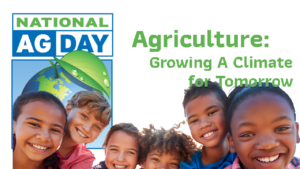In Part 1 of this two-part series on how scientists are working to ensure future food security, I set the stage for why researchers are working diligently to counteract the effects of climate change in the area of agriculture. In this article, I’ll discuss what they are doing in more detail. As pointed out in the previous article, both plants and animals are impacted by climate change. Justin Gillis (@JustinHGillis) reports that scientists from Harvard conclude, “Crops grown in environments designed to mimic future conditions have serious deficiencies of certain nutrients, compared with crops of today.” [“Testing Future Conditions for the Food Chain,” The New York Times, 22 September 2014] And Evan Halper (@evanhalper), writes, “Warmer temperatures can create huge problems for animals farmed for food. Turkeys are vulnerable to a condition that makes their breast meat mushy and unappetizing. Disease rips through chicken coops. Brutal weather can claim entire cattle herds.” [“Scientists race to develop farm animals to survive climate change,” The Los Angeles Times, 3 May 2014] To address these challenges, scientists are using traditional methods, like experimentation and breeding; but, as Eric Orts (@EricOrts) and Joanne Spigonardo (@spigonaj), professors at the Wharton School, University of Pennsylvania, tell us, a new tool is now in the kit — Big Data analytics. [“Can Big Data Feed the World?” Knowledge@Wharton, 12 September 2014]
As noted in my earlier article, Halper reports that scientists at the University of Delaware “are trying to map the genetic code of bizarre-looking African naked-neck chickens to see if their ability to withstand heat can be bred into flocks of U.S. broilers.” Halper reports that Gale Strasburg, a professor of food science and human nutrition at Michigan State University, is trying to develop more robust turkeys. He explains:
“Strasburg’s research involves turning up the heat lamps several degrees on hundreds of turkey chicks, as well as on turkey eggs before they hatch. Researchers will then study the animals’ muscles and attempt to parse out genes that could help the animals endure hotter environments. The hope is ultimately to enable the industry to breed turkeys resilient to heat waves.”
Although breeding more resilient animals may provide part of the solution, many critics believe that a bigger part of the solution will be getting consumers to eat less meat. Alan Miller, a former principal climate-change specialist at the World Bank, told Halper, “The meat industry should be more radical in confronting climate change.” Miller supports “an approach backed by Microsoft founder Bill Gates that takes animals out the process altogether.” Halper explains:
“The billionaire is bullish on technology that would use pea proteins to create replicas of beef and chicken that are indistinguishable from the real thing. ‘There’s no way to produce enough meat for 9 billion people,’ Gates wrote recently on his blog. ‘Yet we can’t ask everyone to become vegetarians. We need more options for producing meat without depleting our resources.'”
For more on that topic, read my article entitled “Technology and Food.” The beef industry is aware of the criticism and, Halper reports, “At Oklahoma State University, scientist Megan Rolf says her efforts could result in herds of cattle that consume less water and feed.” He continues:
“Finicky consumers complicate the work for researchers. The Brahman breed of cattle, for example, a rugged specimen with roots in India, is undeterred by hot, harsh conditions. One place it doesn’t do well, though, is in American taste tests. Rolf’s goal is to create an uber-steer as resilient as a Brahman and tasty as an Angus.”
Botanists face as many challenges as their biologist counterparts. Facing crop damage and loss as a result of changing weather patterns, Gillis reports that scientists are asking, “What can be done to make crops more resilient?” Despite the challenges ahead, Gillis indicates that some scientists believe there is “enormous potential for agriculture to adapt to climatic change, with shifts in farming practices and with improved crop varieties.” He reports, for example, “Led by Dr. [Andrew D.B.] Leakey and Elizabeth A. Ainsworth, a scientist with the United States Agriculture Department, the researchers have created an unusual blend of climate science, agriculture and modern genetics to study possible routes to a more resilient food supply.” All of this research is being assisted by Big Data analytics. One the most impactful ways that Big Data analytics has assisted the field of botany is by enabling marker-assisted breeding. James C. Carrington, president of the Donald Danforth Plant Science Center, told Orts and Spigonardo, “Marker-assisted breeding techniques allow scientists to determine in the lab, within a matter of days, ‘which of the progeny of [cross-pollinated plants], which of the seeds, contain the combination of traits that you want. In other words, you can get an analytical readout from a machine, and you don’t have to wait until you test and grow up all of the seed.’ Naturally, this shortens development time dramatically.” Ort and Spigonardo continue:
“The work of marker-assisted breeding does not involve the genetic manipulation used to produce genetically modified plants or GMOs, which is why a number of environmental activists support it. Instead, it starts with sequencing the genome of a particular crop. ‘Ten years ago, if you sequenced a genome, it would have cost you $100 million. Nowadays, it’s almost for nothing,’ Carrington says. Sequencing the billions of nucleotides in a plant’s genome is now ‘frankly trivial to do.'”
By any measure, that advancement in analytics is revolutionary. Ort and Spigonardo detail how the analytic process works and why it requires Big Data analytical techniques. They go on to note that as complicated as the basic analysis is, it gets more complicated when it moves from the lab into the real world. They explain:
“Since plant genes interact with the environment — the same seed will produce a different plant in Missouri than it will in Maine — scientists have to determine and incorporate in their data how genomes perform across a wide range of environments. Only then can a breeder know which exact hybrid is best for a particular area.”
Ort and Spigonardo report that most of the research being done in this area is being supported by large seed companies like Monsanto. Obviously, these seed companies are looking for a return on their investments and their business model has generated almost as much criticism as their products have praise. Ort and Spigonardo explain that some of this criticism is unjustified:
“The companies do not, as many mistakenly believe, render [first-generation] seeds sterile or forbid farmers from planting them. Farmers take the companies’ advice about not planting the seeds because they know that the next generation will be nothing like the crop they originally planted. So the farmers come back to the seed companies each season to buy the carefully grown first-generation offspring of the same two purebreds. Carrington describes this as a win-win business proposition: The seed companies profit from continuing sales and farmers profit from seeds that produce row after row of vigorous crops, all with the traits they paid for.”
Big Data analytics play an equally important role in the fields of farmers. No two fields are alike, even on the same farm. That is why Ted Crosbie, a science fellow at Monsanto, told Ort and Spigonardo that farmers can no longer afford to play the averages. “When we average things out,” he stated, “we average out a lot of value.” Using Big Data analytics on the farm to increase crop yields is known as precision farming. To learn more about that topic, read my article entitled “Big Data Analytics Could Produce Big Results in the Agricultural Sector.” Here’s the rub. Ort and Spigonardo note, “Big Data is needed most by farmers who can least afford it.” Efforts are needed to help poorer farmers feed those around them. Technology can help and it is increasingly available to them. Ort and Spigonardo report:
“New agricultural cell phone and tablet applications are … being developed for Africa, where there are now more mobile phones than in the U.S. or Europe and where there has been a 20-fold increase in Internet bandwidth since 2008. These apps are connecting farmers to financing, market information, agricultural expertise and sometimes simply to each other so they can share information and best practices.”
But those technologies need to affect decisions in the field as well. Ort and Spigonardo conclude:
“The common thread running through all these efforts is the need to make vital data of all types available without charge to everyone. In a recent speech at the G-8 Conference on Open Data for Agriculture, Bill Gates urged incentives for scientists and organizations to share data and the development of common data standards, easing the exchange of information between organizations and individuals. ‘To reap the benefits of Big Data, it’s important to ensure this is publicly available and shared with research and development partners,’ Gates said. ‘Only then will we be able to create a rich data ecosystem to support the knowledge-intensive and location-specific enterprise of agriculture. This is especially important in developing countries.'”
Food security is both a local and a global problem. Lack of food security in Africa or Asia or Latin America will affect food security elsewhere — not to mention to the humanitarian tragedy created when people are starving. Fortunately, scientists around the globe understand the urgency of the situation and are working diligently to address it.




